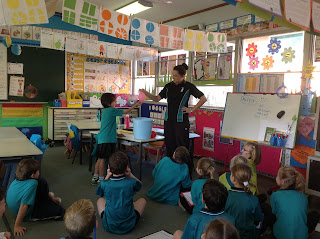On Thursday, we were lucky enough to be the only year twos and threes to visit Warren from the Murdoch University. Warren came down to talk to us about the desalination process and using our water sustainably.
Not one of us even knew what desalination was! So we starting off watching this sort clip to get our brains thinking! Just click on the link below to view!

Warren started by giving us a taste of desalinated water, which we thought was delicious and then he gave us a taste of 'normal tap water' which most of us spat out because it tasted salty! We think Warren was trying to trick us!!
Next, Warren explained to us how much water was on Earth and how much of that water was fresh. In this photo, the big jug of blue water represents all the salty ocean water on our Earth. The smaller jug of blue water shows the fresh water that is found in ice burgs and glaciers, and the smallest container of blue water is the amount of fresh water we have access to!
We were pretty surprised to find this out and a little concerned! Warren reassured us that we have more than enough water though, but we do need to make sure we look after it!
Warren explained that on average Perth consumes
1 Gigalitre a day! That is
1, 000, 000, 000 litres!
To help us understand this massive number, he explained it is like 1 whole Subiaco oval filled to the top each day!......Phew! That is A LOT OF WATER!
Warren explained that at the moment we are taking most of our water from the reserves that are deep underground. He said that we are taking more than we should be and that this is affecting the environment. That is why they have built a desalination plant in Biningup. Warren helped us understand what desalination is by using this experiment:
He put some water in the kettle and added some food colouring to it, which made it yellow. The he taped one end of a tube around the nozzle and the other he sealed into a cup. Then he boiled the kettle and asked us what colour we thought the water in the cup would be. It ended up being clear! Warren explained that this is similar to what happens to salt from ocean water when it is desalinated.
After that, Warren used his super duper micro scope camera to show us some close ups of Isabelle and Claire's skin on the big screen! We could see every tiny little cell! It was amazing!
Warren used his super duper micro scope to show us the filters inside the desalination tubes. These filters only allow water molecules to pass through and all the salt, viruses and bacteria get left behind.
Here are some close up pictures of two types of filters that are used in the desalination process.
Did you know that once the ocean water is desalinated, it is pumped into our normal water reservoirs and it is mixed with rain and ground water before coming through our taps!
Click on this link to take a virtual tour of the Southern Seawater Desalination Plant in Biningup!
We really enjoyed learning about desalination and looking after our Earths resources in a sustainable way! We hope you have learnt a thing or two also!
Over and Out
Tremendous T4



















